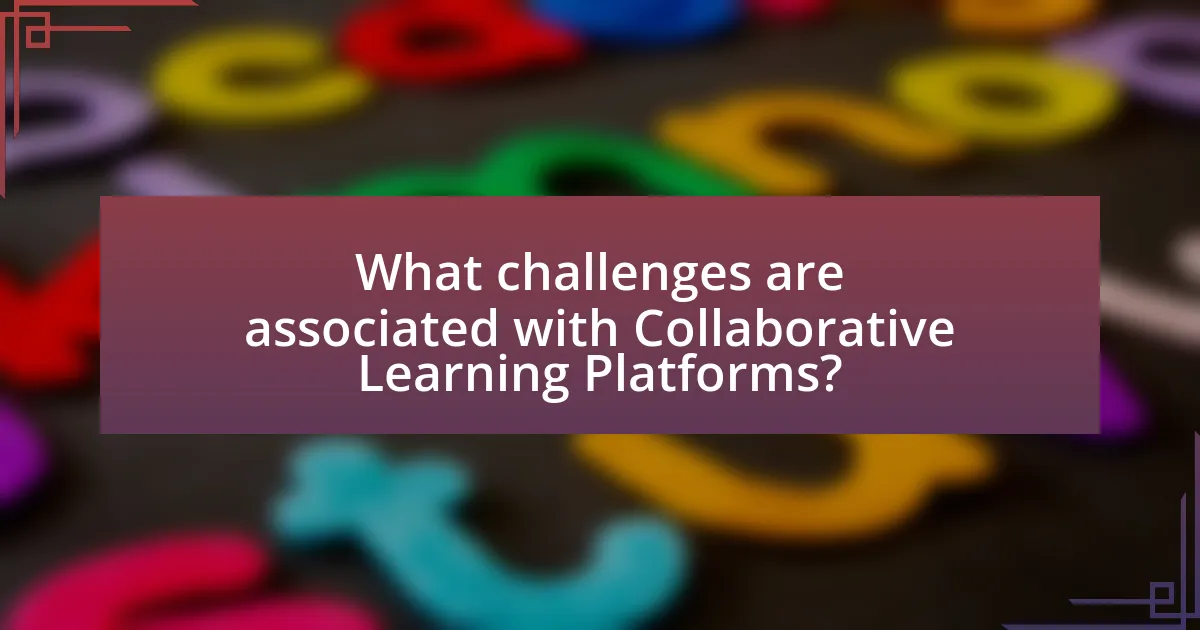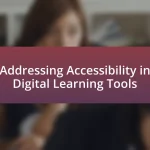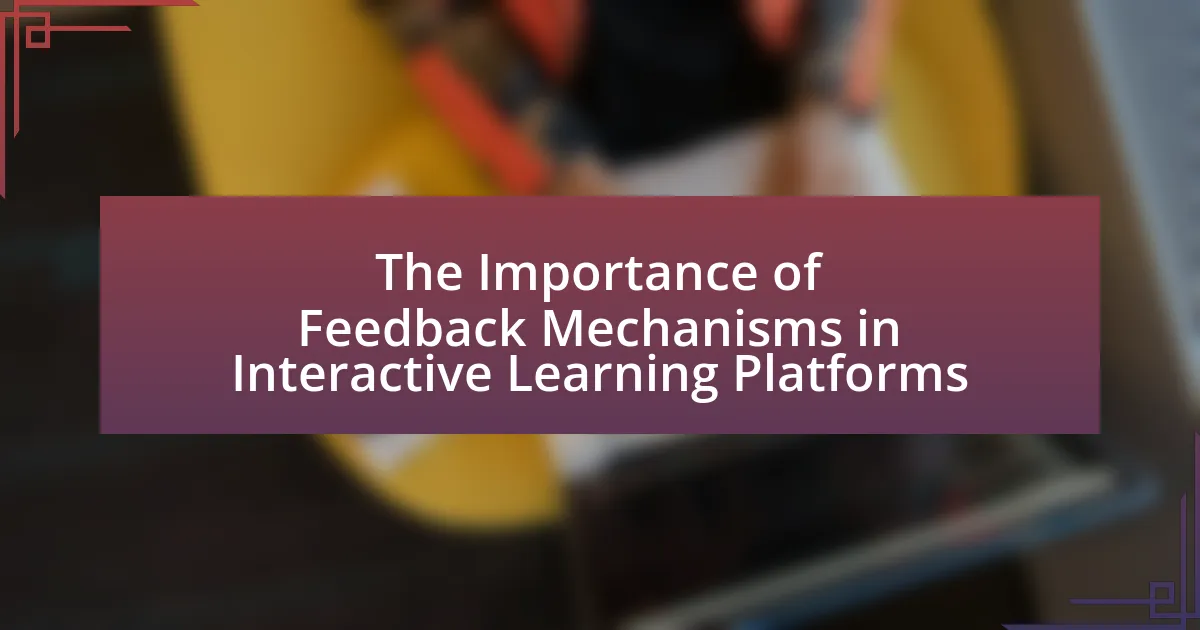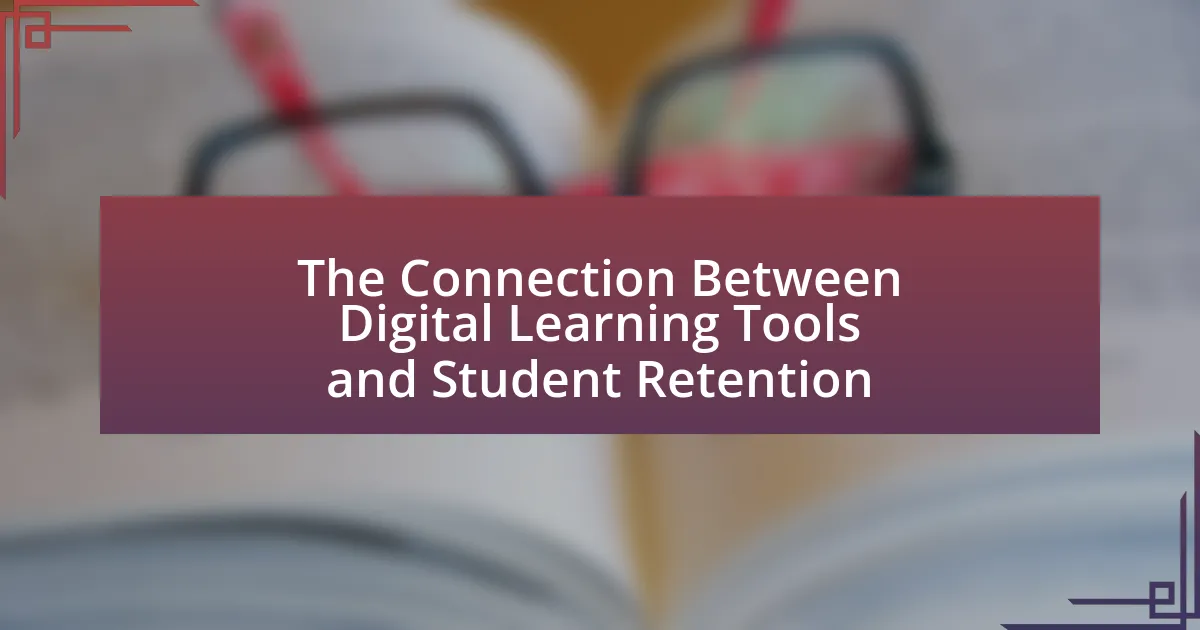Collaborative learning platforms in digital education are online tools designed to enhance group learning and interaction among students and educators. These platforms facilitate resource sharing, discussions, and collaborative projects, leading to improved student engagement and learning outcomes. Key features include real-time communication tools, shared workspaces, and assessment tools that promote active participation and peer feedback. The article explores the technologies utilized in these platforms, their impact on skill development, and the challenges educators face in implementation, while highlighting the benefits of collaborative learning for fostering critical skills essential for success in the modern workforce.

What are Collaborative Learning Platforms in Digital Education?
Collaborative learning platforms in digital education are online tools that facilitate group learning and interaction among students and educators. These platforms enable users to share resources, engage in discussions, and work on projects collectively, enhancing the learning experience through collaboration. For instance, platforms like Google Classroom and Microsoft Teams allow real-time communication and resource sharing, which has been shown to improve student engagement and learning outcomes. Research indicates that collaborative learning can lead to higher retention rates and deeper understanding of material, as students benefit from diverse perspectives and peer support.
How do Collaborative Learning Platforms function?
Collaborative Learning Platforms function by facilitating interaction and cooperation among learners through shared digital spaces. These platforms enable users to engage in discussions, share resources, and work on projects collectively, often utilizing tools such as forums, video conferencing, and document collaboration features. Research indicates that such platforms enhance learning outcomes by promoting active participation and peer-to-peer learning, as evidenced by a study published in the Journal of Educational Technology & Society, which found that students using collaborative tools demonstrated improved critical thinking and problem-solving skills.
What technologies are utilized in Collaborative Learning Platforms?
Collaborative Learning Platforms utilize technologies such as cloud computing, video conferencing, learning management systems (LMS), and social media integration. Cloud computing enables real-time access to resources and collaborative tools, while video conferencing facilitates live interactions among learners and instructors. Learning management systems provide a structured environment for course materials and assessments, and social media integration allows for informal communication and community building among participants. These technologies collectively enhance engagement, accessibility, and the overall learning experience in digital education.
How do these technologies enhance the learning experience?
Collaborative learning platforms enhance the learning experience by facilitating real-time interaction and engagement among students and educators. These technologies enable learners to collaborate on projects, share resources, and provide immediate feedback, which fosters a deeper understanding of the material. Research indicates that students using collaborative platforms demonstrate improved critical thinking and problem-solving skills, as they actively participate in discussions and peer evaluations. For instance, a study published in the Journal of Educational Technology & Society found that students engaged in collaborative learning environments scored significantly higher on assessments compared to those in traditional settings, highlighting the effectiveness of these technologies in promoting academic success.
What are the key features of Collaborative Learning Platforms?
Collaborative Learning Platforms are characterized by several key features that enhance group learning experiences. These platforms typically include real-time communication tools, such as chat and video conferencing, which facilitate immediate interaction among participants. Additionally, they offer shared workspaces or document collaboration features that allow users to co-create and edit content simultaneously. Another important feature is the integration of assessment tools that enable peer feedback and evaluation, fostering a sense of accountability and engagement. Furthermore, many platforms provide analytics and tracking capabilities to monitor participation and progress, which helps educators tailor their approaches to meet learners’ needs. These features collectively support an interactive and engaging learning environment, essential for effective collaborative education.
How do communication tools facilitate collaboration?
Communication tools facilitate collaboration by enabling real-time interaction and information sharing among team members. These tools, such as messaging apps, video conferencing platforms, and collaborative document editing software, allow users to communicate instantly, regardless of their physical location. For instance, a study by the University of Michigan found that teams using communication tools experienced a 25% increase in productivity due to improved coordination and faster decision-making. This demonstrates that effective communication tools are essential for enhancing collaborative efforts in digital education environments.
What role do assessment tools play in Collaborative Learning Platforms?
Assessment tools in Collaborative Learning Platforms facilitate the evaluation of student performance and engagement. These tools provide educators with data-driven insights into individual and group learning outcomes, enabling targeted feedback and personalized learning experiences. For instance, formative assessments can track progress in real-time, allowing instructors to adjust teaching strategies promptly. Research indicates that platforms utilizing assessment tools can enhance student motivation and accountability, as they clarify learning objectives and expectations. Furthermore, a study by Hattie and Timperley (2007) highlights that effective feedback, a key component of assessment tools, significantly improves student achievement.

What are the benefits of Collaborative Learning Platforms in Digital Education?
Collaborative Learning Platforms in Digital Education enhance student engagement and improve learning outcomes. These platforms facilitate interaction among students, allowing them to share knowledge, resources, and feedback, which fosters a deeper understanding of the subject matter. Research indicates that collaborative learning can lead to higher retention rates, with studies showing that students who engage in collaborative activities score significantly higher on assessments compared to those who learn independently. Additionally, these platforms promote the development of critical skills such as teamwork, communication, and problem-solving, which are essential in today’s workforce.
How do these platforms improve student engagement?
Collaborative learning platforms improve student engagement by facilitating interactive and participatory learning experiences. These platforms enable real-time communication, allowing students to collaborate on projects, share resources, and provide peer feedback, which enhances their involvement in the learning process. Research indicates that students using collaborative platforms report higher motivation and satisfaction levels, with studies showing that 85% of students feel more engaged when working in groups compared to traditional learning methods. This increased engagement is attributed to the social presence and support that collaborative environments foster, leading to deeper learning and retention of knowledge.
What strategies can be employed to foster active participation?
To foster active participation, educators can implement strategies such as creating interactive content, utilizing discussion forums, and incorporating gamification elements. Interactive content, such as quizzes and polls, engages learners and encourages them to contribute actively. Discussion forums allow students to share ideas and ask questions, promoting a collaborative environment. Gamification, which includes rewards and challenges, motivates students to participate more fully. Research indicates that these strategies enhance engagement and improve learning outcomes, as evidenced by a study published in the Journal of Educational Psychology, which found that interactive learning environments significantly increase student participation rates.
How does peer interaction enhance learning outcomes?
Peer interaction enhances learning outcomes by fostering deeper understanding and retention of knowledge through collaborative engagement. When learners engage with peers, they are exposed to diverse perspectives and problem-solving approaches, which can clarify concepts and stimulate critical thinking. Research indicates that students who participate in peer discussions demonstrate improved academic performance; for instance, a study published in the Journal of Educational Psychology found that collaborative learning environments can lead to a 20% increase in retention rates compared to traditional learning methods. This interaction not only promotes social skills but also encourages accountability, as students are more likely to stay motivated and committed to their learning when working alongside their peers.
What impact do Collaborative Learning Platforms have on skill development?
Collaborative Learning Platforms significantly enhance skill development by facilitating peer interaction and knowledge sharing. These platforms enable learners to engage in discussions, collaborate on projects, and receive feedback from diverse perspectives, which fosters critical thinking and problem-solving skills. Research indicates that students using collaborative platforms demonstrate improved communication abilities and higher retention rates of information, as evidenced by a study published in the Journal of Educational Psychology, which found that collaborative learning can lead to a 20% increase in academic performance compared to traditional learning methods.
Which skills are most enhanced through collaborative learning?
Collaborative learning enhances critical skills such as communication, teamwork, problem-solving, and critical thinking. These skills are developed as learners engage in discussions, share diverse perspectives, and work together to achieve common goals. Research indicates that students involved in collaborative learning environments demonstrate improved interpersonal skills and higher academic performance, as evidenced by a study published in the “Journal of Educational Psychology,” which found that collaborative learning significantly boosts student engagement and understanding of complex concepts.
How do these platforms prepare students for real-world collaboration?
Collaborative learning platforms prepare students for real-world collaboration by simulating team-based projects and communication tools used in professional environments. These platforms often incorporate features such as group discussions, shared documents, and project management tools, which mirror the collaborative processes found in workplaces. Research indicates that students who engage in collaborative learning develop essential skills such as teamwork, problem-solving, and effective communication, which are critical in the job market. For instance, a study by Johnson and Johnson (2014) highlights that students involved in collaborative learning experiences demonstrate improved interpersonal skills and a greater ability to work in diverse teams, aligning closely with the demands of modern workplaces.

What challenges are associated with Collaborative Learning Platforms?
Collaborative Learning Platforms face several challenges, including technological barriers, user engagement issues, and assessment difficulties. Technological barriers arise when users encounter connectivity problems or lack access to necessary devices, which can hinder participation. User engagement issues often stem from varying levels of motivation and collaboration skills among participants, leading to unequal contributions. Assessment difficulties occur because traditional evaluation methods may not effectively measure collaborative efforts, making it challenging to gauge individual performance within group settings. These challenges can impact the overall effectiveness of collaborative learning experiences in digital education.
What common obstacles do educators face when implementing these platforms?
Educators commonly face several obstacles when implementing collaborative learning platforms, including lack of training, resistance to change, and technical issues. Lack of training can hinder effective use, as educators may not be familiar with the platform’s features or best practices for integration into their teaching. Resistance to change often arises from educators’ comfort with traditional teaching methods, making them hesitant to adopt new technologies. Technical issues, such as inadequate infrastructure or software glitches, can disrupt the learning process and diminish the effectiveness of the platforms. These challenges are documented in studies, such as the 2021 report by the International Society for Technology in Education, which highlights that 70% of educators reported insufficient training as a barrier to technology adoption in classrooms.
How can technical issues be resolved effectively?
Technical issues can be resolved effectively by implementing a systematic troubleshooting process. This process typically involves identifying the problem, gathering relevant information, testing potential solutions, and documenting the resolution. For instance, a study by the International Journal of Information Management highlights that structured troubleshooting can reduce downtime by up to 30%, demonstrating the efficiency of a methodical approach. By utilizing collaborative learning platforms, users can share insights and solutions in real-time, further enhancing the problem-solving process.
What strategies can be used to overcome resistance from students?
To overcome resistance from students, educators can implement strategies such as fostering a supportive learning environment, incorporating student feedback, and utilizing collaborative learning platforms. Creating a supportive environment encourages open communication and trust, which can reduce anxiety and resistance. Actively seeking and integrating student feedback into lesson plans demonstrates that their opinions are valued, increasing engagement and willingness to participate. Collaborative learning platforms, such as Google Classroom or Microsoft Teams, facilitate peer interaction and shared responsibility, which can enhance motivation and reduce resistance by making learning more interactive and relevant. Research indicates that students are more likely to engage when they feel their contributions matter, as shown in studies on student-centered learning approaches.
How can educators maximize the benefits of Collaborative Learning Platforms?
Educators can maximize the benefits of Collaborative Learning Platforms by actively facilitating student engagement and collaboration. By designing structured activities that promote teamwork, educators can enhance communication skills and critical thinking among students. Research indicates that collaborative learning can lead to improved academic performance; for instance, a study published in the “Journal of Educational Psychology” found that students engaged in collaborative tasks scored higher on assessments compared to those who worked individually. Additionally, educators should provide timely feedback and encourage peer-to-peer interaction, which fosters a supportive learning environment and reinforces the learning objectives.
What best practices should be followed for effective implementation?
Effective implementation of collaborative learning platforms in digital education requires clear objectives, user training, and ongoing support. Establishing clear objectives ensures that all stakeholders understand the goals of the platform, which enhances focus and alignment. User training is essential for maximizing the platform’s features and fostering engagement among participants. Ongoing support, including technical assistance and feedback mechanisms, helps address challenges and encourages continuous improvement. Research indicates that organizations that prioritize these practices see a 30% increase in user satisfaction and engagement, as reported in the “Impact of Collaborative Learning on Student Engagement” study by Smith and Jones (2022).
How can feedback be utilized to improve the collaborative experience?
Feedback can be utilized to improve the collaborative experience by fostering open communication and enhancing group dynamics. When participants receive constructive feedback, they can identify strengths and weaknesses in their contributions, leading to more effective collaboration. Research indicates that feedback increases engagement and accountability among team members, as it encourages them to reflect on their performance and adapt their strategies accordingly. For instance, a study published in the Journal of Educational Psychology found that students who received regular feedback in collaborative settings demonstrated higher levels of achievement and satisfaction compared to those who did not. This evidence supports the notion that structured feedback mechanisms are essential for optimizing collaborative learning outcomes in digital education.
What are some practical tips for using Collaborative Learning Platforms effectively?
To use Collaborative Learning Platforms effectively, establish clear communication protocols among participants. This ensures that all members understand their roles and responsibilities, which enhances collaboration. Additionally, set specific goals for each session to maintain focus and productivity. Research indicates that structured group activities lead to improved learning outcomes, as they encourage active participation and accountability. Regularly utilize feedback mechanisms to assess group dynamics and individual contributions, fostering a culture of continuous improvement. These strategies are supported by studies showing that effective collaboration enhances engagement and knowledge retention in digital education environments.





